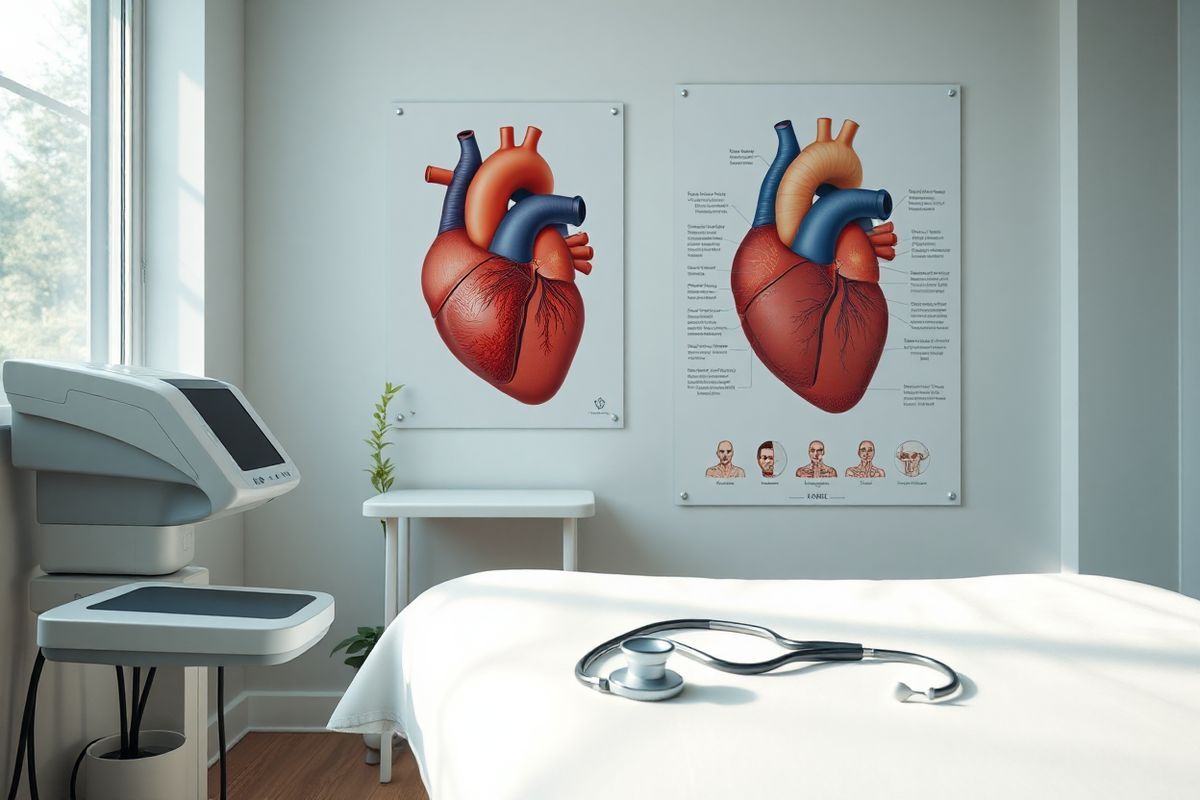Table of Contents
Understanding Heart Failure: Symptoms and Diagnosis

heart failure occurs when the heart muscle is unable to pump blood effectively, leading to inadequate blood flow to meet the body’s demands. Symptoms can manifest gradually or suddenly and may include:
- Shortness of breath (dyspnea) during activity or while lying down
- Fatigue and weakness
- Swelling in the legs, ankles, and feet due to fluid retention
- Rapid or irregular heartbeat (arrhythmia)
- Coughing or wheezing, particularly when lying down
- Increased need to urinate at night
- Nausea and loss of appetite
- Confusion or decreased alertness due to reduced blood flow to the brain
Diagnosis typically involves a combination of medical history assessment, physical exams, and diagnostic tests such as blood tests, chest X-rays, echocardiograms, and electrocardiograms (ECG) (Mayo Clinic, 2024).
Diagnostic Tests Table
| Test Type | Purpose |
|---|---|
| Blood Tests | Detects heart failure biomarkers (e.g., BNP) |
| Chest X-ray | Evaluates heart size and fluid accumulation |
| Electrocardiogram (ECG) | Assesses heart rhythm and electrical activity |
| Echocardiogram | Visualizes heart structure and function |
| Stress Test | Measures heart performance under physical stress |
Exploring Medical Treatments: Medications and Lifestyle Changes

The management of heart failure initially focuses on medication and lifestyle modifications. Common medications include:
- ACE inhibitors: Help relax blood vessels, lowering blood pressure and reducing strain on the heart.
- Beta-blockers: Slow heart rate and improve heart function.
- Diuretics: Help remove excess fluid from the body.
- Aldosterone antagonists: Reduce fluid retention and improve heart function.
- SGLT2 inhibitors: Originally for diabetes, these medications have shown benefits in heart failure management.
In addition to medications, lifestyle changes play a critical role in managing heart failure. Patients are often advised to:
- Follow a heart-healthy diet low in salt and saturated fats
- Engage in regular physical activity as tolerated
- Maintain a healthy weight
- Limit alcohol consumption and quit smoking
- Manage stress and ensure adequate sleep
Surgical Procedures for Heart Failure: When and Why They Are Needed
When heart failure progresses despite optimal medical therapy, surgical interventions may be necessary. Surgical options can be categorized into two main types: corrective procedures and assistive devices.
Corrective Procedures
-
Heart valve Surgery: Damaged or diseased heart valves can lead to heart failure. Surgical intervention may involve valve repair or replacement to restore normal blood flow.
-
coronary Bypass Surgery: This procedure is used when heart failure is related to coronary artery disease. Surgeons bypass blocked arteries to improve blood flow to the heart muscle.
-
Coronary Angioplasty: A minimally invasive procedure where a balloon is used to open narrowed arteries, often followed by stenting.
Assistive Devices
-
Left Ventricular Assist Device (LVAD): This mechanical pump helps the heart pump blood, often used as a bridge to heart transplantation or as a long-term solution for patients who are not candidates for a transplant.
-
Implantable Cardioverter-Defibrillator (ICD): This device monitors heart rhythms and delivers shocks to restore normal rhythm when necessary.
-
cardiac Resynchronization Therapy (CRT): This therapy is for patients with heart failure and electrical conduction problems, helping the heart chambers beat in sync.
Advanced Surgical Techniques: Innovations in Heart Failure Treatment
Advancements in surgical techniques continue to improve outcomes for heart failure patients. Innovations include:
-
Minimally Invasive Surgery: Techniques such as endoscopic or robotic-assisted surgery reduce recovery times and complications associated with traditional open-heart surgery.
-
Hybrid Procedures: Combining surgical and catheter-based techniques for comprehensive treatment, particularly in complex cases.
-
New Device Technologies: Continuous development of more effective and durable LVADs and other devices to assist heart function.
Innovations Table
| Technology | Description |
|---|---|
| Minimally Invasive Surgery | Uses small incisions for quicker recovery and less pain |
| Robotic-Assisted Surgery | Enhances precision and control during surgery |
| Advanced LVAD Systems | Improved durability and functionality for long-term support |
Post-Surgery Care and Recovery: Ensuring Long-Term Heart Health
Recovery from heart surgery requires careful monitoring and rehabilitation. Key components of post-surgery care include:
-
Cardiac Rehabilitation: A structured program that includes supervised exercise, education on heart-healthy living, and counseling to improve heart health and quality of life.
-
Medication Management: Adjusting medications as needed and ensuring adherence to prescribed regimens.
-
Regular Follow-Up: Continuous monitoring by healthcare providers to assess heart function and make necessary adjustments to treatment.
-
Lifestyle Adjustments: Ongoing emphasis on diet, exercise, and lifestyle modifications to prevent recurrence of heart failure.
Frequently Asked Questions (FAQ)
What are the signs that I may need surgery for heart failure?
If you experience worsening symptoms despite medication adherence, such as increasing shortness of breath, fatigue, or swelling, it’s crucial to consult your healthcare provider about surgical options.
How do I prepare for heart surgery?
Preparation may include medical evaluations, lifestyle modifications, and discussions about the procedure, risks, and recovery with your healthcare team.
What is the recovery time after heart surgery?
Recovery times vary depending on the procedure, but patients can generally expect several weeks to months before returning to normal activities.
Are there risks associated with heart surgery?
As with any surgical procedure, risks can include infection, bleeding, and complications related to anesthesia. Your healthcare provider will discuss specific risks based on your condition.
Can heart failure be reversed?
While heart failure is a chronic condition, appropriate medical and surgical treatments can significantly improve symptoms and quality of life, and in some cases, reverse the progression of the disease.
References
- Mayo Clinic. (2024). Heart failure - Symptoms and causes. https://www.mayoclinic.org/diseases-conditions/heart-failure/symptoms-causes/syc-20373142
- Mayo Clinic. (2024). Heart failure – Diagnosis and treatment. https://www.mayoclinic.org/diseases-conditions/heart-failure/diagnosis-treatment/drc-20373148
- Cleveland Clinic. (2023). Acute Heart Failure: Symptoms, Causes & Treatment. https://my.clevelandclinic.org/health/diseases/21686-acute-heart-failure
- NHS. (2023). Heart failure - Treatment. https://www.nhs.uk/conditions/heart-failure/treatment/
- Hurley Medical Center. (2024). Types of Surgery










